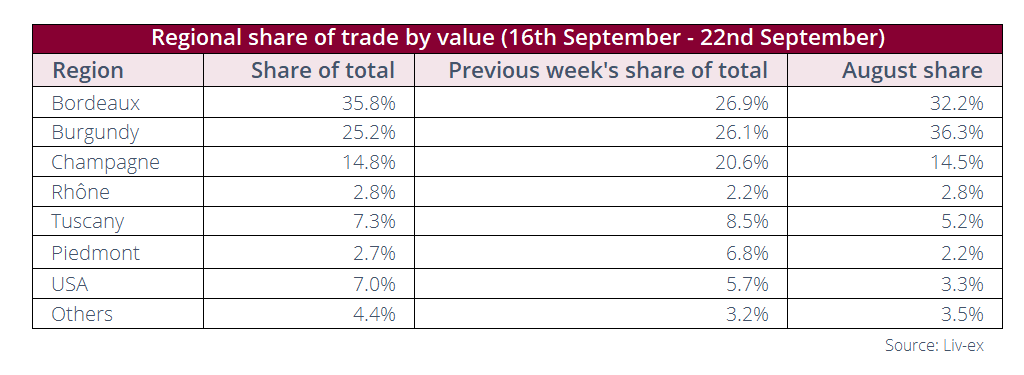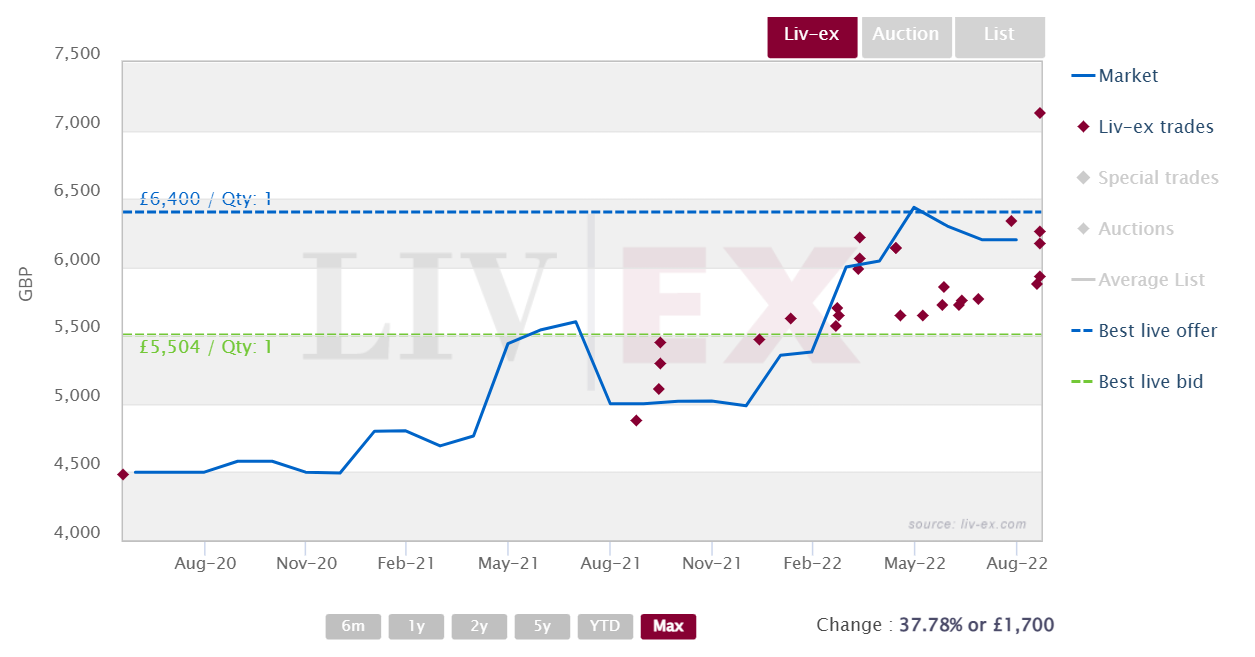- Bordeaux, the Rhône, USA and the ‘others’ increased their weekly share of trade.
- Louis Roederer Cristal 2014 was this week’s top traded wine.
- The UK Chancellor cancelled planned duty rises and the new duty system has been laid out following consultation
Regional trade this week

Bordeaux increased its weekly trade share from 26.9% to 35.8%, mostly driven by activity for its 2018 and 2019 vintages. Château Lafite Rothschild was its most active label by value and Château Talbot by volume.
The USA also rose, accounting for 7% of the total trade, with Screaming Eagle, Opus One and Promontory at the centre of demand.
Trade for the ‘others’ was on the up, dominated by Australia (0.6%), Germany (0.6%), Spain (0.4%) and Switzerland (0.3%), which saw demand for Pinot Noir from Weingut Gantenbein.
Meanwhile, E. Guigal’s Côte-Rôtie La Mouline and Château-Grillet were the leading labels from the Rhône this week.
This week’s top traded

Louis Roederer Cristal once again led the market with its 2014 vintage, which has been the most traded wine this quarter. It last traded at £2,494 per 12×75, up 3.9% on its release price.
Screaming Eagle Cabernet Sauvignon also featured in the rankings for the second week in a row, with another 100-point vintage – the 2018. Writing for The Wine Advocate at the time, Lisa Perrotti-Brown MW described it as ‘undeniably stunning’.
Meanwhile, Château Cheval Blanc 2019 set a new trading high this week at £7,124 per 12×75, which represents a 58.1% increase on its release price. Across Cheval Blanc’s last 15 vintages, the 2019 has been the top price performer year-to-date.
The estate has also been the most traded wine from Saint-Émilion so far in 2022, with prices rising 20.4% on average over the past three years. Yesterday saw the release of its white wine, Le Petit Cheval Blanc 2020, through La Place de Bordeaux.
Cheval Blanc 2019 trades on Liv-ex

Weekly recap
Fiscal Statement and Alcohol Duty Review response
The UK’s new Chancellor of the Exchequer, Kwasi Kwarteng, delivered a fiscal statement to the House of Commons this morning (23rd September).
In it he announced that the planned increase in duty rates for beers, wines and spirits will be cancelled. Furthermore, the government has published its response to the consultation on the Alcohol Duty Review which can be found here.
The response outlines the new duty system as follows:
- The new duty regime will take effect from 1 August 2023.
- Removing the higher rate for sparkling wine.
- For an 18-month period between 1 August until 1 February 2025, all wine between 11.5% alcohol by volume (ABV) and 14.5% ABV will be taxed at 12.5%.
- After this period, all wine in that range will be expected to have duty calculated based on the labelled ABV.
- Further consultation will take place on a number of technical questions and also the definition of cider for tax purposes.
- The fiscal forecast will continue to be based on the assumption that duty rates will be increased – however rates will be frozen for this year.
In response to the announcement, the WSTA’s CEO Miles Beale said:
‘We welcome the Government’s sensible decision to freeze duty on wine and spirits. However the Government’s response to the consultation on reviewing the way the UK taxes alcohol is a product of the Sunak era and clashes strongly with Chancellor Kwarteng’s desire to unleash the potential of the private sector and to simplify taxation. The proposals mean wine between 11.5% and 14.5% will be taxed at the mid-point – but only for 18 months. After that the Treasury are set to tax wine by strength adding a costly administrative burden for UK wine businesses and consumers. Fortified wine will be offered no transition, meaning the outlook is even worse.
For months the WSTA has been calling for a simpler system for wine taxation which would cut costly red tape. The response published today fails to do so – or to understand the impact that taxing wine by strength will have on the UK wine businesses and consumers.
We need a permanent and simple way of taxing wine, the UK’s most popular alcoholic drink. An 18-month transitional period fails to do this and it is not available to all wines.
These latest proposals will be bad news for consumers worried about the cost of living; and create complexity, burden and cost for UK businesses. They also fail to take advantage of measures that could support the new Chancellor’s aims for private sector-inspired growth the British economy.’
Other wine market news
In the rest of the fine wine market news, the autumn La Place de Bordeaux campaign is nearing its end. This week’s offerings included Telmo Rodriguez’s Yjar 2018, the first Rioja launched though the network, ex-cellar stock of Château Palmer 2012 and the first release of Château Haut-Batailley 2016, which was not sold during the 2017 En Primeur campaign. Our full coverage can be found here.
Liv-ex members received further analysis on secondary market buying habits and Burgundy’s top traded appellations this year.
Liv-ex analysis is drawn from the world’s most comprehensive database of fine wine prices. The data reflects the real time activity of Liv-ex’s 600 merchant members from across the globe. Together they represent the largest pool of liquidity in the world – currently £80m of bids and offers across 16,000 wines. Independent data, direct from the market.
Not a member of Liv-ex? Request a demo to see the exchange and a member of our team will be in touch with you shortly.





